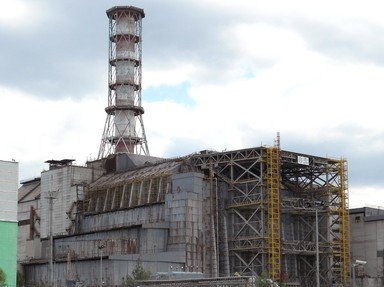Quiz Answer Key and Fun Facts
1. April 25, 1986, 1:06 am: Chernobyl reactor block #4 is starting to reduce power output in anticipation of a planned shutdown. Engineers are standing by to use this shutdown procedure for a repetition of a test the unit had failed a year before. Which system was the key system to be tested?
2. April 25, 1986, morning hours: With the reactor down to half power, the electrical grid controller requested further shutdown measures be postponed due to the unexpected failure of another power station. The shutdown process resumed normally at 11:04 pm, but in the meantime a seemingly trivial, but crucial event had occurred. What was it?
3. April 26, 1986, 12:05 am: The gradual shutdown now had the reactor at 700 Megawatts output - slightly less than a quarter of the maximum and the right power for the test. However, instead of stabilizing at this level, what next happened to the power output?
4. April 26, 1986, 12:28 am: With the reactor in an undesired condition, one of the operators made an understandable decision that could have ended the situation safely but would prove fatal when it was decided to go ahead with the test after all. What did he do?
5. April 26, 1986, 1:05 am: After a long period of adjustments, the operators had managed to restore the reactor to a stable 200 Megawatt output. It was too low for the test specification, but the decision was made to proceed. The reactor was, unknown to the operators, now in a very unstable state. Which of the following did NOT contribute to this state?
6. April 26, 1986, 1:23:04 am: The reactor operators were ready to begin the fateful experiment. To simulate the failure condition, the steam feed to the main turbine was turned off. Inertia took over and the turbine still drove the generator while the diesels started up. What was the outcome of the scheduled experiment itself?
7. April 26, 1986, 1:23:40 am: An operator pushed the EPS-5 button which initiated a manual SCRAM - an immediate, quick shutdown of the entire reactor. Both automatic and manual control rods began their insertion into the core. Unlike in many other reactors, this insertion was however not gravity-driven but done by motors. How long would a full insertion have taken?
8. April 26, 1986, 1:23:45 am: A final construction flaw in the Chernobyl reactor manifested itself and a massive power spike - at least ten times the maximum rated output of the reactor - fatally overheated the entire core within seconds. Which element of the reactor showed this final and fatal flaw?
9. April 26, 1986, 1:24 am: With power exceeding ten times normal operating limits (according to the last registered measurement) and rising, the disaster was inevitable. A massive explosion literally tore the roof off the building. What caused this explosion?
10. April 26, 1986, 2:00 am: Due to a quick reaction of the fire department, many of the resulting fires were already under control, but one substance would continue to burn with extreme heat for many days, causing heated radioactive gases to be propelled high up into the atmosphere and turning what could have remained a relatively local radioactive pollution event into the national and global disaster it became. What substance was this final aggravating factor?
Source: Author
WesleyCrusher
This quiz was reviewed by FunTrivia editor
bloomsby before going online.
Any errors found in FunTrivia content are routinely corrected through our feedback system.

